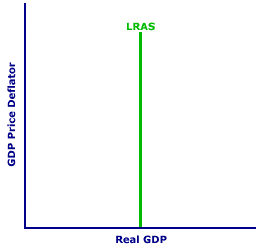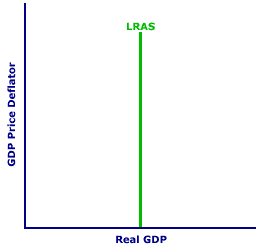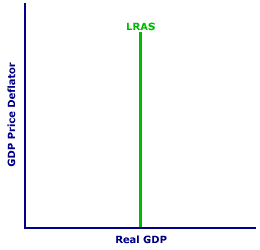
|
|
DEMAND CURVE: A graphical representation of the relationship between the demand price and quantity demanded (that is, the law of demand), holding all ceteris paribus demand determinants constant.
Visit the GLOSS*arama
|
|


|

|
                           LONG-RUN AGGREGATE SUPPLY CURVE: A graphical representation of the long-run relation between real production and the price level, holding all ceteris paribus aggregate supply determinants constant. The long-run aggregate supply curve, abbreviated LRAS, is one of two curves that graphically capture the supply-side of the aggregate market. The other is the short-run aggregate supply curve. The demand-side of the aggregate market is occupied by the aggregate demand curve. The vertical long-run aggregate supply curve captures the independent relation between real production and the price level that exists in the long run. The long-run aggregate supply curve reflects the lack of a cause-and-effect relation between real production and the price level. As the price level rises, real production remains constant at the full-employment level. As the price level falls, real production remains constant at the full-employment level. Due to flexible prices, the same level of real production is generated at every price level. Interaction between the long-run aggregate supply curve and the aggregate demand curve, as well as the short-run aggregate supply curve is the core mechanism of the aggregate market (or AS-AD) analysis. This analysis is then used to explain and understand macroeconomic phenomenon, including business cycles, inflation, unemployment, and stabilization policies. The Long-Run Aggregate Supply Curve| Long-Run Aggregate Supply Curve |  |
A typical long-run aggregate supply curve, labeled LRAS, is presented in this graph. Consider a few highlights.- First, the price level is measured on the vertical axis and real production is measured on the horizontal axis. The price level is usually measured by the GDP price deflator and real production is measured by real GDP.
- Second, the long-run aggregate supply curve is a vertical line. The aggregate real production offered for sale by the business sector is the same at higher price levels as it is at lower price levels. This constant level of aggregate real production is full-employment production.
- Third, the price level and aggregate real production are the only two variables allowed to change in the construction of this curve. Everything else that could affect long-run aggregate supply is assumed to remain constant. Analogous to market supply, these other variables are ceteris paribus factors that fall under the heading of aggregate supply determinants.
- Fourth, this long-run aggregate supply curve captures the relation between the price level and the flow of real production over a given time period. However, depending on the particular aggregate market analysis, the time period could be shorter (several months) or longer (several years). Of course, if the time period is too short, then the long-run aggregate supply curve might not be relevant.
Moving Along the LRAS Curve| Along the Curve |  |
The vertical long-run aggregate supply curve captures the independent relation between the price level and aggregate real production. The price level does NOT affect long-run aggregate real production. A higher price level generates the same real production as a lower price level. However, from a graphical standpoint, it is possible to consider how changes in the price level can cause a movement along the long-run aggregate supply curve. To illustrate this, click the [Change Price Level] button.In the analysis of the aggregate market, the price level generally changes in response to a disequilibrium in the economy. While the change in the price level leads to changes in aggregate expenditures on the demand side of the aggregate market and short-run aggregate real production, it does NOT cause changes in long-run aggregate real production. The price level change does cause a movement along the vertical long-run aggregate supply curve, but this is not associated with any quantity change. Shifting the LRAS Curve| Shifting the Curve |  |
The long-run aggregate supply curve is constructed assuming all aggregate supply determinants remain unchanged. Should any of these determinants change, the long-run aggregate supply curve shifts to a new position. The long-run aggregate supply curve can either shift rightward (an increase in aggregate supply) or leftward (a decrease in aggregate supply). Click the [Increase in LRAS] and [Decrease in LRAS] buttons to illustrate.Shifts of the long-run aggregate supply curve can be brought about by such things as technology or changes in resource quantities. While changes in aggregate supply determinants and resulting shifts of the long-run aggregate supply curve are less dramatic than changes affecting aggregate demand, they DO change. In most cases the changes are slow and steady, for example, the natural growth of the population. From time to time, however, shifts in the long-run aggregate supply curve are more abrupt, such as energy shortages during the 1970s. The long-run aggregate supply curve is shifted due to changes by any (ceteris paribus) factor other than the price level. Two broad determinant categories include: - Resource Quantity: This determinant is the quantity of the resources--labor, capital, land, and entrepreneurship--that the economy has available for production. If the economy has more resources, then aggregate supply increases and the long-run aggregate supply curve shifts rightward. With fewer resources, aggregate supply decreases and the long-run aggregate supply curve shifts leftward. Specific determinants in this category include population growth, labor force participation, capital investment, and exploration.
- Resource Quality: This determinant is the quality of resources, especially technology and education. If the quality of labor, capital, land, and entrepreneurship change, then aggregate supply changes and the long-run aggregate supply curve shifts. An improved quality increases aggregate supply, triggering a rightward shift of the long-run aggregate supply curve, and a decline in quality decreases aggregate supply, generating a leftward shift of the long-run aggregate supply curve.

Recommended Citation:LONG-RUN AGGREGATE SUPPLY CURVE, AmosWEB Encyclonomic WEB*pedia, http://www.AmosWEB.com, AmosWEB LLC, 2000-2025. [Accessed: July 1, 2025].
Check Out These Related Terms... | | | | | | | | | |
Or For A Little Background... | | | | | | | | | |
And For Further Study... | | | | | | | | | | |
Search Again?
Back to the WEB*pedia
|



|

|
BLACK DISMALAPOD
[What's This?]
Today, you are likely to spend a great deal of time looking for a downtown retail store looking to buy either a dozen high trajectory optic orange golf balls or a large red and white striped beach towel. Be on the lookout for the happiest person in the room.
Your Complete Scope
This isn't me! What am I?
|

|
|
The standard "debt" notation I.O.U. does not mean "I owe you," but actually stands for "I owe unto..."
|

|
|
"Experience keeps a dear school, but fools will learn in no other. " -- Benjamin Franklin
|

|
DW
Durbin-Watson
|

|
|
Tell us what you think about AmosWEB. Like what you see? Have suggestions for improvements? Let us know. Click the User Feedback link.
User Feedback
|


|


